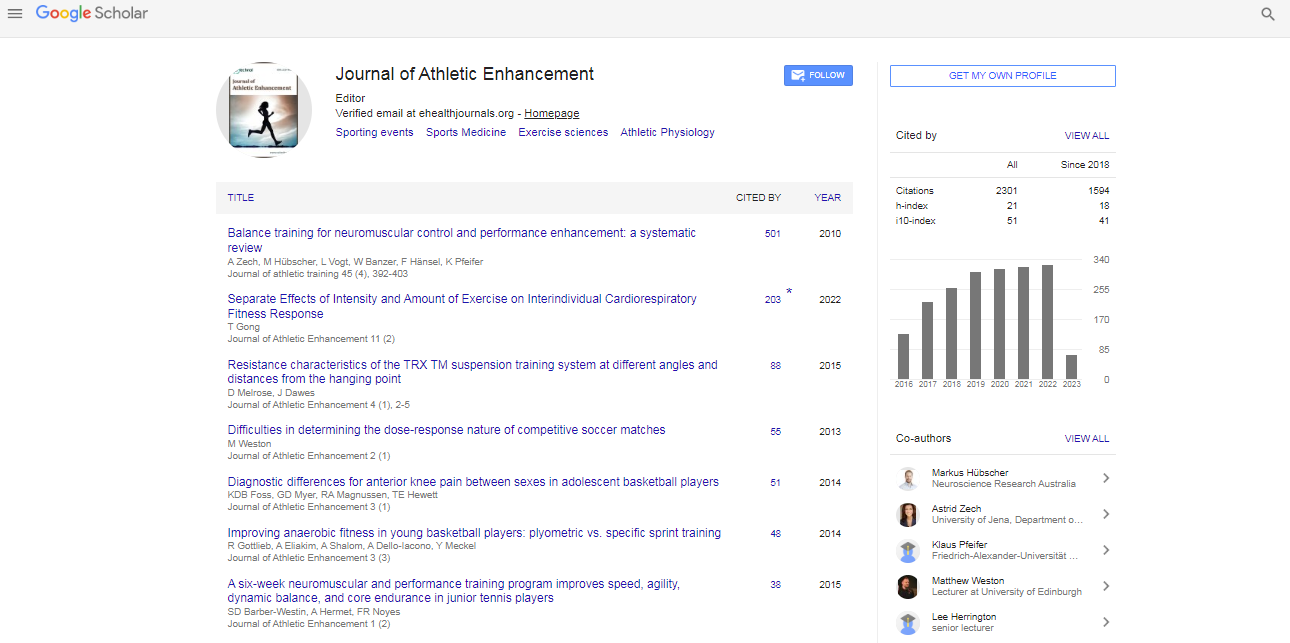Commentary, J Athl Enhanc Vol: 12 Issue: 6
Athletic Physiology and Athletic Performance: A Comprehensive Study
Jack Schweickle*
1Department of Mental Health and Sport, University of Wollongong, Wollongong, Australia
*Corresponding Author: Jack Schweickle,
Department of Mental Health
and Sport, University of Wollongong, Wollongong, Australia
E-mail: schweickle_jack@uow.edu.au
Received date: 30 October, 2023, Manuscript No. JAE-23-124065;
Editor assigned date: 02 November, 2023, PreQC No. JAE-23-124065 (PQ);
Reviewed date: 16 November, 2023, QC No. JAE-23-124065;
Revised date: 23 November, 2023, Manuscript No. JAE-23-124065 (R);
Published date: 30 November, 2023 DOI: 10.4172/2324-9080.100084
Citation: Schweickle J (2023) Athletic Physiology and Athletic Performance: A Comprehensive Study. J Athl Enhanc 12:6.
Description
Athletic physiology delves into the intricate workings of the human body during exercise and athletic performance. It's a multifaceted field that combines elements of physiology, biomechanics, nutrition, and psychology to understand how the body responds, adapts, and excels in athletic endeavors.
The physiology of exercise
Exercise triggers a cascade of physiological responses. When engaged in physical activity, the body's demand for oxygen and nutrients increases, necessitating adjustments in various systems:
Cardiovascular system: The heart pumps more blood to deliver oxygen and nutrients to working muscles. With regular exercise, the heart becomes more efficient, increasing stroke volume and cardiac output.
Respiratory system: Breathing rate and depth elevate to supply more oxygen to muscles and expel carbon dioxide. Enhanced lung function aids in oxygen uptake and utilization.
Muscular system: Muscles undergo complex changes during exercise. They contract, generating force and movement. Strength training induces muscle hypertrophy, enhancing strength and endurance.
Energy systems: Three energy systems phosphagen, glycolytic, and oxidative provide ATP (adenosine triphosphate) for muscle contractions. Different activities engage these systems to varying degrees.
Adaptations to training
Advancements in technology, such as wearable devices, biofeedback systems, and genetic testing, are revolutionizing how athletes train and monitor their performance. These tools provide realtime data for personalized training and injury prevention.
Regular training induces physiological adaptations that optimize athletic performance:
Muscle adaptation: Exercise stimulates muscle growth, endurance, and strength. Resistance training increases muscle fiber size and strength, while endurance activities enhance mitochondria density, improving aerobic capacity.
Cardiovascular adaptation: Endurance training enhances the heart's efficiency, lowering resting heart rate and increasing stroke volume. This improves oxygen delivery to muscles.
Respiratory adaptation: Aerobic training improves lung function, increasing oxygen uptake and delivery to muscles while aiding in carbon dioxide removal.
Neuromuscular adaptation: Enhanced coordination, motor control, and neuromuscular efficiency improve movement patterns and skill execution.
Nutrition and performance
Athletic physiology is a dynamic field that continues to evolve, providing insights into the human body's incredible adaptability and performance potential. Understanding these physiological intricacies empowers athletes, coaches, and sports scientists to optimize training, enhance performance, and promote overall well-being in the world of sports and athleticism.
Nutrition plays a pivotal role in athletic performance and recovery:
Macronutrients: Carbohydrates, fats, and proteins serve as primary energy sources. Athletes require adequate intake of these nutrients for energy, muscle repair, and overall health.
Hydration: Proper fluid intake is crucial for maintaining performance and preventing dehydration, which can impair physical and cognitive function.
Micronutrients: Vitamins and minerals support various physiological functions, such as bone health, immune function, and energy metabolism.
While training stimulates adaptation, excessive training without adequate recovery can lead to overtraining syndrome, characterized by fatigue, decreased performance, and increased injury risk. Proper recovery strategies like rest, nutrition, sleep, and active recovery are crucial for optimal performance.
Psychology in athletics
Athletic physiology acknowledges individual variations in response to training, influenced by genetics, age, sex, and environmental factors. Tailoring training programs to individual needs optimizes performance outcomes.
The mind plays a pivotal role in athletic performance:
Mental preparation: Techniques such as visualization, goal setting, and positive self-talk enhance focus and confidence.
Stress and anxiety management: Managing stress and anxiety is essential for peak performance. Techniques like mindfulness and relaxation help athletes stay composed under pressure.
 Spanish
Spanish  Chinese
Chinese  Russian
Russian  German
German  French
French  Japanese
Japanese  Portuguese
Portuguese  Hindi
Hindi 
